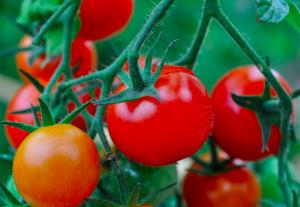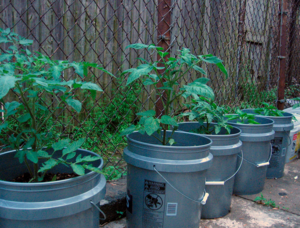
The tomato plant is a fruit but is usually treated as a vegetable for the purposes of culinary use.
For a bountiful garden that will feed a family through the warmer months, grow around eight to 15 tomato plants. Extra tomatoes you can't use will always be willingly accepted by the neighbours.
Growing tomatoes[edit | edit source]
Decide whether to grow from seed or seedlings. If growing from seed, start early to ensure that the seedlings are ready in time for catching the warm season's beginning.
Seeds need warmth to germinate, so if you live in a cool to cold climate, start the seeds in little pots or seed containers indoor first.
Don't put seedlings out until there is no further risk of frost. The seedlings cannot cope with frost. Alternatively, rig up a covering for them, at night and should any untoward weather occur during the day.
In the garden[edit | edit source]
Choose a sunny place in the garden. Tomatoes love and thrive on plenty of sunshine. Prepare the soil well. Dig in rotted garden compost, poultry pellets or well rotted manure into a soil that drains freely. Tomato plants prefer rich and fertile soil.
Tomato plants can handle both light and heavy soils but the soil must be able to drain. There is no need to add lime unless the pH is 5.5 or lower. Space tomato plants 50cm or more apart. This space is required to accommodate the fruit, of which hopefully you'll get plenty. This includes small tomatoes, such as cherry tomatoes, as these form in plentiful bunches that still take up plenty of room.
In a container[edit | edit source]

Tomatoes grow well in containers, provided the container is sufficiently large and the soil used drains easily. The container should be placed in full sun, as for growing in the garden.
Ongoing care for tomatoes[edit | edit source]
Give the tomatoes stakes. Vine and bush tomato varieties need to be attached to a stake in order to be able to bear the fruit and stay upright. Use soft cloth or soft ties, so as not to damage the stems. Old clothes, pantyhose or thrift store supplies of ribbon, yarn, etc., make for excellent sources to produce homemade ties.
Water and feed tomatoes regularly. They cannot be left to grow without sufficient water. Consider a top-up of homemade fertilizer or well-rotted compost/manure. At the first sign of fruit, feed with tomato liquid fertiliser. It is vital that the plant does not dry out from the time the fruit sets until you pick it.
As the tomatoes grow, removing a few leaves assists the growth. It is recommended that you do the following:
- Pinch out the laterals (small side shoots on leaf axils on the tomato's main stem). This will encourage vigorous and bushy growth.
- Remove the growing tip from the top of the main stem when a good four to five trusses are formed. This helps the plant to concentrate most on fruit production and less on continuing to grow leaves and stems.
- Pull away the lower leaves that are obscuring the fruit. This allows more light to reach the fruit. If grown in a container, the container can be moved around to allow the fruit to get more light too.
Problems[edit | edit source]
Tomatoes can impacted by the following pests: Aphids, leafhoppers, red spider mites, whitefly and thrips.
Diseases that can affect tomatoes include: Food and root rots, tomato ghost spot, spotted wilt virus, blossom end rot, tomato blight and leaf moulds.
[A separate article needs to be created to address these problems, addressing both conventional and organic approaches.]
Companion planting[edit | edit source]
Tomatoes and basil grow well together. They taste brilliant served together too.
Harvesting[edit | edit source]
A healthy, average tomato plant will produce around 4 to 5 kilograms of fruit.
Although harvesting occurs when the fruit is ripe (red), it is possible to use green tomatoes that aren't likely to ripen in time by season's end, turning them into pickles, fried dishes, and so forth. You can also ripen those last green tomatoes indoors.
Uses for tomatoes[edit | edit source]
Tomatoes have many culinary uses. They are ideal enjoyed fresh in salads, on top of pasta and in sandwiches. A bountiful harvest of tomatoes can be made into tomato sauce, tomato ketchup, pickles, tomato jam, puree, pasta sauce, and so on.
Tomato varieties[edit | edit source]
There are many varieties of tomatoes, some of which are listed following.
- Beafsteak
- Better Boy
- Big Boy
- Brandywine
- Cherry
- Heirloom
- Plum
- Roma
See also[edit | edit source]
- Food
- Preserving Tomatoes (FAO, 35 p.)
External links[edit | edit source]
- tomatoes without irrigation - video
- tomatoes without irrigation - discussion thread